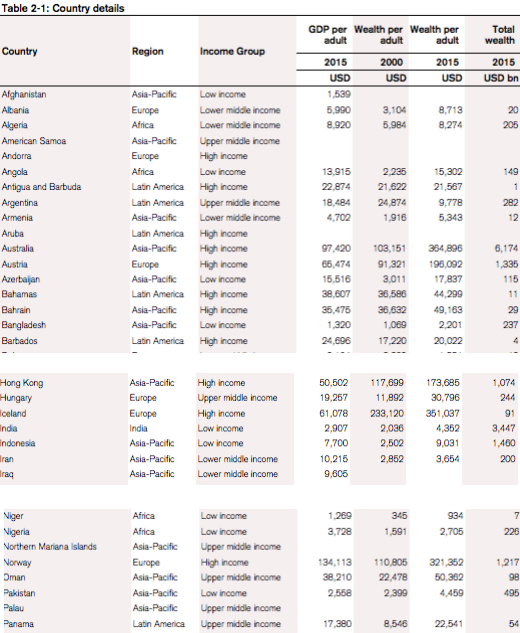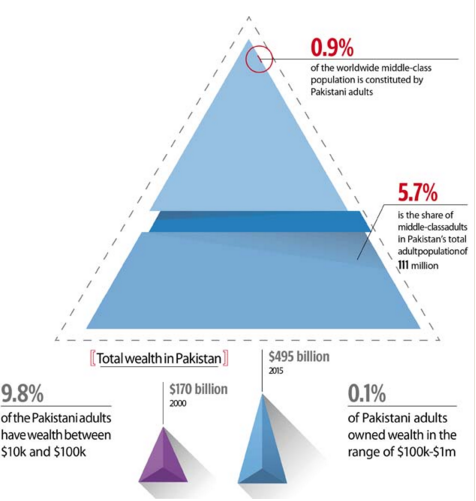PakAlumni Worldwide: The Global Social Network
The Global Social Network
Middle Class Pakistanis Richer Than Their Indian Counterparts
Pakistan’s middle class consists of over 6.27 million adults, according to wealth criteria used by Credit Suisse in its Global Wealth Report 2015. It represents 5.7% share of Pakistan’s total adult population of 111 million, almost twice as large as India’s middle class made up of 3% of its adult population based on the same criteria.
Average ($4,459) and median ($2,216) wealth figures for Pakistani middle class adults are higher than average ($4,352) and median ($868) wealth figures for their Indian middle class counterparts. It's a consequence of lower income wealth inequality in Pakistan compared to its neighbor. For comparison, only 1.1% of Bangladesh adult population qualify as middle class. Their average wealth is $2,201 and median wealth $1,102 per adult.
Pakistan Wealth Source: Global Wealth Report 2015 Via Express Tribune |
Credit Suisse's report estimates Pakistan's total private wealth in mid-2015 at $495 billion, Bangladesh's at $237 billion and India's at $3.45 trillion.
Credit Suisse said Pakistan's middle class is the 18th largest and India's 8th largest in the world. The report says 14% of world adults qualify as middle class in 2015 and they own 32% of the world's wealth. 6.7 million Pakistani adults make up 0.9% of the world's middle-class adult population. China tops the list with 108.7 million, followed by the United States 91.8 million and Japan 62 million.
A little more than 90% Pakistani adults had wealth less than $10,000 in 2015. The share of Pakistani adults with wealth between $10,000 and $100,000 in 2015 was 9.8% while only 0.1% adults owned wealth in the range of $100,000 and $1 million, the report revealed.
Other studies based on income criteria of $2 or more per day put Pakistan's middle class at 55% of the population. A 2010 ADB report titled "Asia's Emerging Middle Class: Past, Present and Future" report put Pakistan's middle class growth from 1990 to 2008 at 36.5%, much faster than India's 12.5% growth in the same period. Other reports have indicated Pakistan's median per capita income is higher than both India's and Bangladesh's.
Even though Pakistan's GDP growth has been relatively low compared to India and Bangladesh in recent years, the country's middle class has continued to grow rapidly. It's explained as follows: It's not the overall GDP growth and average per capita income and wealth increases but the median per capita income and wealth growth that tells you how the GDP gains are shared among the population.
Data shows that economic gains in Pakistan are shared better than India and Bangladesh because of lower inequality. Income poverty rate (those below $1.25 per capita per day) in India is 33% and Bangladesh 43% versus 13% in Pakistan, according to WB data on povcalNet. Gini Index for India is 33, Pakistan 29 and Bangladesh 32, indicating that Pakistan has lower inequality.
Related Links:
Pakistan's Middle Class Grows to 55%
Median Per Capita Incomes of Bangladesh, India and Pakistan
India and Pakistan Compared in 2014
-
Comment by Riaz Haq on October 17, 2015 at 9:15pm
-
The growing middle class
SHAHID KARDAR — PUBLISHED OCT 28, 2014 06:29AM
THERE is a visible demographic shift in Pakistan. We have been experiencing steady growth in an aspiring middle class and not just in terms of absolute numbers. Despite lacklustre growth during the last decade, the middle class has grown faster than the country’s population and nowhere has its growth and broadening been as sharp as in Punjab, especially central Punjab and the Potohar belt. Both areas are characterised by a less skewed distribution of land holdings and a more educated and skilled labour force.
How do we define ‘middle class’? It is a variable and nebulous term. The numbers or size of this class changes according to an economic or sociological definition. It is inaccurate to generalise, because the middle class is not homogenous in character. Although some values and characteristics are common for all segments that make up this class, there are differing worldviews.
In economic terms, it can be defined on the basis of incomes, consumption, and ownership of select durable assets, say the type of house one has, (all three being linked). A workable definition by the economist is that the middle class refers to people who have approximately one-third of their income available to spend after meeting their basic needs of food and shelter.
In sociological terms, it can be defined by occupation, occupational level, education or self-identification, the latter reflecting a sense of self-ascription: one belongs to the middle class because one envisions a middle-class lifestyle and identity for oneself. It is the class of seekers and strivers putting in the most effort for change in search of a secure future. For instance, they want to educate their girls for better marriage prospects in mobile, upwardly families, which would enable better social connections. For this upward mobility, migration to urban areas is an important strategic move.
Government policies and the nature and level of spending have also influenced the pace of the middle class’s creation. Recent, rapid growth in retail trade has been the most conspicuous outcome of this: new shopping malls and restaurants have emerged even in small towns, spawning a demand for a whole new set of skills, thereby further expanding its size.
In demographic terms, households at the lower end of the scale comprise a third to half the population (although our classification of the top 10pc as ‘the rich’ would be misleading by world standards). They are typically owners of small shops and workshops, middle-sized farmers, petty contractors, semi-skilled industrial and service workers and junior- or mid-level official cadre.
A substantial proportion of them are also beneficiaries of a large range of government handouts and subsidies, including water, fertiliser, higher education, wheat flour, etc. They typically own a refrigerator, more than one mobile phone, a motorbike or a small car. Although their expenditure budgets are stretched, they save for the education of their children and for their retirement.
Those at the upper end are senior government officials, managers of large businesses, bankers, professionals like accountants, tax consultants and architects, large farmers, academics in upmarket private schools and in public and private universities and those providing a whole range of services in the sectors of telecommunication, IT, media and retail and allied services, etc.
They are brand conscious, want material possessions like designer clothes, the latest car models, electronic gadgets, have air-conditioners and can afford some kind of annual vacation.
http://www.dawn.com/news/1140783
-
Comment by Riaz Haq on October 18, 2015 at 3:36pm
-
Local car sales jump 72% in Pakistan
KARACHI: Local car sales (including light commercial vehicles, jeeps and vans) jumped to 54,812 units in the first three months (Jul-Sep) of fiscal year 2016, up 72% compared to 31,899 units in the same period of last year, according to data released by the Pakistan Automotive Manufacturers Association (PAMA).It is important to note that in September 2015, despite fewer working days due to Eidul Azha, local car sales rose 45% year-on-year (YoY) to 18,424 units. They, however, declined by 10% month-on-month (MoM).
The overall healthy growth in the auto sector is indicative of an increase in per capita income, lower interest rates and overall recovery of the economy. Car financing is also picking up gradually (currently estimated at 30% versus 5% a few years ago).
To recall, car sales (excluding imported ones) in Pakistan grew at a five-year (FY11-15) compound annual growth rate (CAGR) of 5.3% to 179,953 units. While volumes surged by 31% in fiscal year 2015 (FY15) on the back of the new model of Toyota Corolla, Punjab taxi scheme and an increase in car financing due to 42-year low interest rates in the country also helped.“We forecast local car sales to grow at 13% in FY16 to reach 203,653 units,” Topline Securities reported on Monday.
Amongst individual companies, Pak Suzuki sales increased by 98% YoY to 33,770 units in 1QFY16 primarily due to the taxi scheme. Volumes declined by 12% MoM.
Indus Motor sold 14,767 units in 1QFY16 compared to 9,862 units in the same quarter last year. In the month of September, Indus Motor’s sales stood at 4,984 units which rose by 6% year on year. On a MoM basis, however, following the trend in Pak Suzuki, Indus sales also decreased by 10%.
Honda Cars sold 6,184 units in 1QFY16 compared to 4,887 units in the same period last year. In September, Honda Cars sold 2,001 units, up by 14% YoY, while remained flat on a MoM basis.
-
Comment by Riaz Haq on October 24, 2015 at 4:22pm
-
I did visit Pew Global and found a July 2015 report " A Global Middle Class Is More Promise than Reality".
http://www.pewglobal.org/files/2015/07/Global-Middle-Class-Report_F...
It shows the following:
Population Below $2 a day India 19.8% in 2011 down from 35.4% in 2001 vs Pakistan 18.1% in 2011 down from 33.3% in 2001
Median Daily Per Capita Income India $2.96 in 2011 up from $2.39 in 2001 vs Pakistan $2.95 in 2011 up from $2.42 2001
While median daily per capita income is about the same, Pakistan still has lower $2 a day poverty level than India.
Anyone above $2 a day is considered middle class by both ADB and World Bank definitions.
http://www.pewglobal.org/files/2015/07/Global-Middle-Class-Report_F...
-
Comment by Riaz Haq on November 27, 2017 at 10:54pm
-
Credit Suisse Wealth Report 2017
India Average Wealth Per Capita $5,976 Gini 83% Household Wealth Up 9.9% since 2016
India Median Wealth Per Capita $1295
Pakistan Average Wealth Per Capita $5,174 Gini 52.6% Household Wealth Up 6.3% since 2016
Pakistan Median Wealth Per Capita $3,338
http://publications.credit-suisse.com/tasks/render/file/index
Comment
Twitter Feed
Live Traffic Feed
Sponsored Links
South Asia Investor Review
Investor Information Blog
Haq's Musings
Riaz Haq's Current Affairs Blog
Please Bookmark This Page!
Blog Posts
Pakistan Downs India's French Rafale Fighter Jets in History's Largest Aerial Battle
Pakistan Air Force (PAF) pilots flying Chinese-made J10C fighter jets shot down at least two Indian Air Force's French-made Rafale jets in history's largest ever aerial battle involving over 100 combat aircraft on both sides, according to multiple media reports. India had 72 warplanes on the attack and Pakistan responded with 42 of its own, according to Pakistani military. The Indian government has not yet acknowledged its losses but senior French and US intelligence officials have …
ContinuePosted by Riaz Haq on May 9, 2025 at 11:00am — 9 Comments
Pahalgam Attack: Why is the Indian Media Not Asking Hard Questions?
A recent terrorist attack on April 22 in Kashmir has killed 26 Indian tourists. Prime Minister Narendra Modi's Hindu Nationalist government took no time to blame Pakistan for the attack and vowed to "punish" the neighbor for it. Indian media, also derisively known as "Godi media", immediately went into overdrive to demand action against Pakistan. New Delhi followed up with suspending the Indus Basin Water treaty from the 1960s which guarantees 80% of the water from the three western rivers…
ContinuePosted by Riaz Haq on April 28, 2025 at 2:00pm — 17 Comments
© 2025 Created by Riaz Haq.
Powered by
![]()


You need to be a member of PakAlumni Worldwide: The Global Social Network to add comments!
Join PakAlumni Worldwide: The Global Social Network